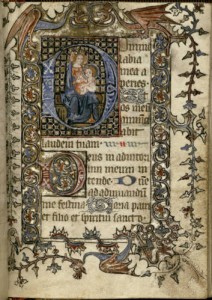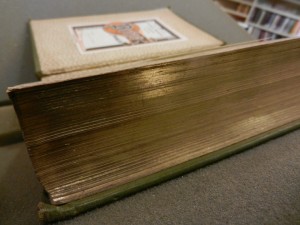
Whether it’s a rare book printing found at long last or piece of ephemera found in an archival collection by chance, those who visit the University of Houston Special Collections almost always find something they cannot wait to share with others. Here we celebrate what makes the University of Houston Special Collections so special–our Favorite Things.
This series is intended to shine a light on some of the most prized things we find here in Special Collections. Sometimes, however, we are reminded that the most special of all aren’t the objects that reside in our stacks, but the people who walk through our doors.
Not long ago I was witness to a special treat in the reading room. Headed out to our foyer desk to greet a patron, I was somewhat surprised when I encountered an elementary school-aged child. While a family member searched the general stacks, this young girl had intrepidly set out in search of older, rarer quarry.
I thought of all the amazing rare books in our collections, and tried to come up with the perfect example to share. Just before we went into the reading room to begin viewing materials, we were joined by Pat Bozeman, Head of Special Collections. Her mind quickly went to the Book of Hours, Use of Reims as a treat worthy of such a delightful and curious patron.
Watching the young researcher excitedly encounter this book was one of my favorite moments since joining the UH Libraries. It was a pleasure to watch and listen as Pat explained how the book was made and pointed out interesting details to a completely captivated child. And the girl’s reactions were a reminder of the wonder that these fantastic holdings have the power to elicit. There are lots of great things about working in the reading room, but there isn’t much that can top a child’s sincere “wow!”
The experience not only underscored the responsibility we here in Special Collections have for preserving and making accessible our cultural heritage, but was also a reminder of just how darn lucky we are to get to do it.
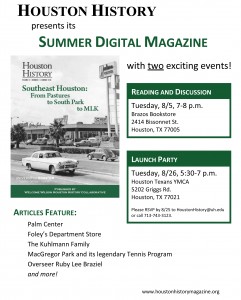
The summer 2014 digital issue of Houston History features a piece on the history of Foley’s in the city of Houston
The second digital issue of Houston History (Summer 2014) is on the virtual shelves and features a piece by our own Dr. Tomkins-Walsh, “From the Archives: Remembering Foley’s,” featuring research and images from the Foley’s Department Store Records.
We have written previously, lamenting the demise of a Foley’s presence, influencing and shaping Houston’s downtown, prior to the ultimate demolition of Kenneth Franzheim‘s bold design. For her part, Dr. Tomkins-Walsh addresses the demolition of that building in September of 2013 as something of a catalyst on the collective, public memory that wants not for a building, but instead represents more of a nostalgia and longing for an old figurative pillar and community partner long gone. From its origins as a dry goods store, to an early department store, through the post-war optimism reflected in the construction of Kenneth Franzheim’s icon, to the role it played in the desegregation of Houston, and on into the growth of branch stores that followed the patterns of suburban development, Tomkins-Walsh outlines in detail the symbiotic relationship that Foley’s enjoyed with the community, as well as the rich research potential the meticulous records hold across a number of fields of study.
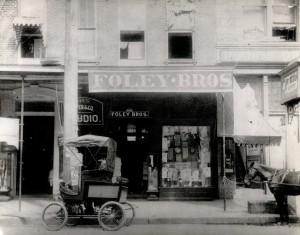
Foley Bros. on Main St. (1906) – available for high resolution download at our digital library
Subscribers of Houston History may read Dr. Tomkins-Walsh’s article and the rest of the latest digital issue online at the magazine’s website. In addition, a launch party for the summer digital issue is scheduled for Tuesday, August 26th from 5:30pm to 7:00pm at the Houston Texas YMCA (5202 Griggs Rd., Houston, TX 77021). Interested in learning more about the history of Houston as seen through that huge display window on Main Street? Plan a visit to the Special Collections Reading Room and take a closer look at the Foley’s Department Store Records.
In addition to the over 7,000 linear feet of archival collections made available for study at the University of Houston Special Collections, we are also proud to offer over 100,000 rare and antique books for use in our reading room. Each month we will highlight a text from our collections and what makes it so special.
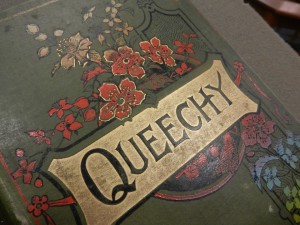
cover of Queechy / by Elizabeth Wetherell (Susan Warner)
Book of the Month: Queechy by Elizabeth Wetherell, as recommended by Julie Grob, Coordinator for Instruction at the University of Houston Special Collections.
Why So Special? “The pictorial cloth binding with a decoration of flowers that are multicolored,” writes Grob. “I’m a sucker for over-the-top publishers bindings from the 19th century, and this is one of the more elaborate in our collection.”
Originally published in 1852, Queechy was Susan Warner’s second novel, following her widely-translated debut, The Wide, Wide World (1850), also written under the pen name Elizabeth Wetherell. That book’s popularity gave Warner the distinction of being one of the most popular authors of a new nation still finding its literary voice. Our copy of Queechy is a glittering and gilded display that no doubt would have brought color to the cheeks of Warner’s Puritan forebearers. “Pictorial green cloth stamped in gold, red, blue, yellow and black. Edges gilt.”
Location: Pictures will not do this one justice. If you would care for a closer look, Queechy is available for study in the University of Houston Special Collections Reading Room, during our normal research hours. To spend some time with Fleda Ringgan as she crisscrosses the Atlantic, please request PS3155.Q4 1800z.
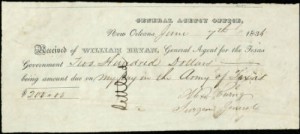
$200 pay certificate for Alexander Wray Ewing (June 7, 1836), for “my pay in the Army of Texas.” Ewing served as surgeon general of the Texas army and, two months prior, had treated Sam Houston at the battle of San Jacinto. — (available for high-resolution download through our Digital Library or for further study via our Early Texas Documents Collection)
The digitization of the Early Texas Documents Collection which has recently been published has been a monumental task several years in the making. With nearly 1,300 items, the documents trace not only the activities of prominent Texans and founders, such as Sam Houston and Stephen F. Austin, but give researchers a glimpse into what life was like for Texans in the early 19th through transactions involving land, finances, legal matters, and in some cases chattel and slaves. In addition, military documents chronicle the Battle of San Jacinto between General Sam Houston and Santa Anna’s forces. There are also military scrips that document the pay soldiers received for their time of service within the Texas Army and Navy.
Genealogists may also find the documents of interest as the subjects of their research may have written letters, or their names may appear on financial or legal documents contained within the collection. The collection also contains early examples of currency utilized during the Republic era. Selections of these currencies have been featured in the exhibit On the Run: Currency, Credit and Capitals of the Republic of Texas this past June at the Texas Capital Visitors Center in Austin. In short, the collection contains something for everyone.
Lauren Bacall, a legend (though she despised the word) and icon of Hollywood’s golden era who taught the world how to whistle, died in New York on Tuesday.
Born Betty Joan Perske to working-class immigrants in Brooklyn, her parents divorced when she was six years old. Her mother, Natlie Perske (maiden name, Weinstein-Bacal) moved to Manhattan and young Betty Joan would go on to usher theaters on Broadway and model dresses on Seventh Avenue before her enigmatic beauty drew inquiries from Hollywood. She left for the West Coast in 1942, reemerging as Lauren Bacall (“Lauren” at the behest of producer and director Howard Hawks, the additional “L” to assist in pronunciation), catching the silver screens aflame with a mystique and unmistakable, smoldering vocal delivery.
“Betty” to long-time friends and family, but always “Baby” to “Bogie,” she sometimes bristled at the attempts of others to define her in the context of that other iconic actor, her screen foil, and her husband (until his death in 1957), Humphrey Bogart. “Being a widow,” she once told an interviewer, “is not a profession.” Bacall and Bogart sparked on and off screen in To Have and Have Not (1944), married in 1945, and would go on to star opposite one another in The Big Sleep (1946), Dark Passage (1947), and Key Largo (1948).
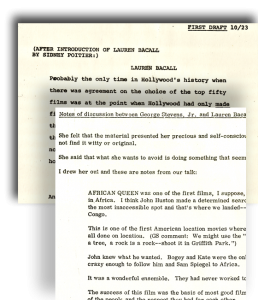
detail from Larry McMurtry’s notes, working with Lauren Bacall and George Stevens, Jr., from the Larry McMurtry Papers
Others will offer up more appropriate insights into the artistry and legacy of Bacall. Today, however, while obituaries abound generously peppered with the name “Bogart,” as she’d once predicted and lamented long before her passing, an interesting item from the Larry McMurtry Papers provides even more context to the Bacall-Bogart dynamic. In 1977 McMurtry worked with Bacall and George Stevens, Jr. as part of “The Stars Salute America’s Greatest Movies,” honoring the best 500 films to date. Bacall was to introduce The African Queen (1951, John Huston), starring her late husband.
McMurtry quotes Bacall on her recollections of the filming of African Queen and Bogart’s co-star, Katharine Hepburn: “John knew what he wanted. Bogey and Kate were the only two stars crazy enough to follow him and [producer] Sam Spiegel to Africa… It was the beginning of my friendship with Katie–an important part of my life and it still is.” Twenty years after Bogart’s death, however, it was clear he still served as a foil. Reflecting on their conversation, McMurtry writes, “In terms of the introduction, she would like it to be clear that she has a reputation of her own–that she is not simply Bogey’s widow. Obviously, it will be clear in her presentation that it is not purely coincidental that she is doing the introduction to AFRICAN QUEEN which starred Bogey.”
She must have known, however, that her legacy remains quite her own. Honored throughout her life by a list that includes the Screen Actors Guild, the Tony Awards, and the Golden Globes, she also received a National Book Award for her autobiography By Myself (1978). While she does recount those famous loves lost (Frank Sinatra once reportedly proposed to Bacall), she also recounts her rise as a starlet in a very particular heyday for Hollywood, including this interesting tidbit on how she went about acquiring her signature sound at the direction of Hawks:
He wanted me to drive into the hills, find some quiet spot, and read aloud. He felt it most important to keep the voice in a low register. Mine started off low, but what Howard didn’t like and explained to me was, “If you notice, Betty, when a woman gets excited or emotional she tends to raise her voice. Now, there is nothing more unattractive than screeching. I want you to train your voice in such a way that even if you have a scene like that your voice will remain low.” I found a spot on Mulholland Drive and proceeded to read The Robe aloud, keeping my voice lower and louder than normal. If anyone had ever passed by, they would have found me a candidate for the asylum. Who sat on mountaintops in cars reading books aloud to the canyons?
The Larry McMurtry Papers are available for study, along with twenty-one other Contemporary Literature collections, in the University of Houston Special Collections Reading Room.
